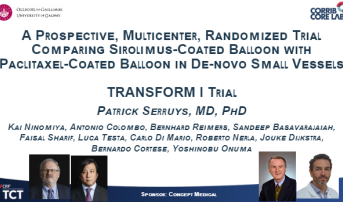Comparing DCBs in De Novo CAD: Drugs, Design Matter
At TCT 2023, two studies of sirolimus- vs paclitaxel-coated devices reached different conclusions about 6-month late lumen loss.

SAN FRANCISCO, CA—For de novo coronary lesions, how well sirolimus-coated balloons (SCB) fare in comparison to paclitaxel-coated balloons (PCB) is still up in the air, according to results from two randomized trials released Tuesday at TCT 2023. The data suggest the efficacy of SCB is dependent on device design, with no class effect.
The TRANSFORM I study, a comparison of MagicTouch SCB (Concept Medical) and SeQuent Please Neo PCB (B. Braun) in small-vessel coronary disease, failed to show noninferiority with the sirolimus device for lumen gain at 6 months. Another study that pitted the SeQuent SCB against the SeQuent Please PCB (both B. Braun), however, did demonstrate noninferiority.
With drug-coated balloons, paclitaxel’s ability to stick around in the tissue is what helps retain vessel patency. This same quality was what made it less desirable in a stent where, over time, it can delay healing. Sirolimus holds appeal as an alternative in part due to paclitaxel’s bad rep in the stent space.
Bruno Scheller, MD (Saarland University, Homburg/Saar, Germany), who presented the more-favorable sirolimus findings at TCT, highlighted paclitaxel’s long history. “We started 20 years ago with paclitaxel, because if you have paclitaxel in the [vessel] wall, it stays there. It has this irreversible binding,” he explained to TCTMD.
Devices featuring sirolimus, in contrast, must be designed in a way to achieve longer drug release, said Scheller. “That’s the challenge for sirolimus-coated balloons. We have different technologies at the moment in preclinical and clinical evaluation, and today we learned that there are differences between those technologies.”
With the highly crystalline coating of the SeQuent SCB, about 50% of the sirolimus is still in the vessel wall, approaching what’s seen with drug-eluting stents, Scheller said. With the MagicTouch SCB, there’s a “very deep decline. . . . After 4 weeks, there’s almost nothing anymore in the wall.”
This factor, he conjectured, is the explanation for the disparate findings.
Patrick W. Serruys, MD, PhD (University of Galway, Ireland), who presented the TRANSFORM I data, also drew attention to the divides between the two drugs. “We know sirolimus is cytostatic with a wide therapeutic range, a slow tissue absorption, a short tissue retention,” he told TCT attendees. “Paclitaxel is cytotoxic with a narrow therapeutic range, a fast tissue absorption, and a long tissue retention.”
So what, then, is the appeal of sirolimus? “It has a little bit to do with psychology, because in the stent field we learned that limus was the winner and paclitaxel creates some vessel remodeling,” Scheller commented to TCTMD. While a paclitaxel-eluting stent was one of the first approved devices in this space, it was quickly supplanted by other agents that caused less inflammation and thrombosis. With drug-coated balloons, “this is fine,” he continued, “but if you have it on a stent, you create late malapposition. . . . It is deep in the brain of most interventional cardiologists that paclitaxel is a bad thing and sirolimus is a good thing.”
This mindset, plus worries about dissection and more familiarity with implanting stents, is what has deterred uptake of paclitaxel-coated DCB in the coronaries, he noted. “In my opinion, the biggest advantage of sirolimus on DCB is that you can convince more interventional cardiologists to reduce the total number of stents and [try] balloons.”
One Win, One Loss
Scheller and colleagues randomly assigned 70 patients with de novo coronary lesions (reference vessel diameter ≥ 2.5 mm) to receive either a SeQuent SCB or a SeQuent Please PCB. For the primary endpoint of late lumen loss at 6 months, the SCB met the noninferiority margin of < 0.35 mm compared with PCB for both in-lesion (mean 0.13 vs 0.03 mm) and in-segment (mean 0.11 vs 0.04 mm) measurements. Late lumen enlargement trended higher with PCB compared with SCB (56% vs 44%) but the difference didn’t reach significance. Clinical outcomes did not differ between the devices. These results, from Europe, compare well with a similar study conducted in Malaysia, Scheller pointed out. “Next steps are longer follow-up and trials with primary clinical endpoint.”
For TRANSFORM I, published in JACC: Cardiovascular Interventions, Serruys and colleagues randomized 121 patients (n = 129 lesions with a reference vessel diameter < 2.75 mm) to receive either the MagicTouch SCB or SeQuent Please Neo PCB. MagicTouch, said Serruys, “was developed using novel technologies, with encapsulation of lipophilic sirolimus into a protective lipophilic package with a unique balloon folding.”
Among the 90.1% of patients with angiographic follow-up at 6 months, net lumen gain at 6 months was 0.25 ± 0.40 mm with the SCB and 0.48 ± 0.37 mm with the PCB. Thus, the SCB failed to meet the noninferiority criterion of 0.30 mm (P for noninferiority = 0.173) for the study’s primary endpoint. Additionally, there was smaller late loss with the PCB than with the SCB (mean 0 vs 0.32 mm; P < 0.001) as well as more frequent late lumen enlargement (53.7% vs 30.0%; P = 0.014) and less frequent binary restenosis (12.5% vs 32.8%; P = 0.012).
Additionally, there was a positive correlation between late lumen loss and dissection volume with SCB, “whereas the relationship was flat with a slightly negative slope” after PCB, the researchers note in their paper. This “confirms that the coating formulation on the MagicTouch does not effectively prevent the restenotic process triggered by increasing barotrauma.”
Serruys concluded: “Larger and longer-term studies powered for clinical outcomes are warranted to determine the efficacy of sirolimus-coated versus paclitaxel-coated balloon and to confirm the absence (or presence) of a class effect in DCBs.”
Still Much to Learn
Bernardo Cortese, MD (Fondazione Ricerca e Innovazione Cardiovascolare, Milan, Italy), a panelist in the session and a co-author of the JACC: Cardiovascular Interventions paper, said that despite their differences, the studies show “paclitaxel, angiographically, is winning.
“On the other hand, we have quite a good amount of data . . . showing that it doesn’t seem so far that there is a correlation between this lower angiographic performance and worse clinical outcomes,” though only time will tell whether this is certain, he noted.
Serruys said that mechanistic studies are needed to get to the root of the sirolimus versus paclitaxel question. But a well-powered clinical trial, he added, could reveal some surprises.
As noted by panelist Sonya Nadine Burgess, PhD (University of New South Wales, Sydney, Australia), the risk with surrogate endpoints is that while “we think we know what’s happening, it’s not until we get clinical endpoints that we really know the right thing for our patients. So I think the important thing is to understand that it’s not necessarily a class effect, to watch carefully, but to not give up on technology before we know if it’s truly helpful or not.”
Antonio Colombo, MD (San Raffaele Scientific Institute, Milan, Italy), who co-moderated the session, pointed out that not all drug coatings have the same structure, but can be amorphous or crystalline, which matters when trying to make comparisons.
“I fully agree,” said Serruys. “If you look at the scanning electron microscopy of all these paclitaxel crystals, the difference is phenomenal.” Paclitaxel is “quite remarkable in general,” but perceptions of its use in coated balloons have been colored by prior experience with drug-eluting stents, he added. And in peripheral artery disease, enthusiasm had been dampened by a signal—now mostly debunked—of higher mortality risk with paclitaxel-based devices.
An interim analysis of their data, said Cortese, did not reveal any difference in clinical outcomes between the two devices or any safety signals.
Serruys said it’s important to realize how widely DCB will be adopted for cardiovascular interventions in the coming years: “I think the prediction is that in 2033, it might be 40% of the [devices used] in practice.” A key question to explore is the relationship between the dissection that can occur during DCB use and subsequent healing, he added, noting that this is why they are pursuing 6-month optical coherence tomography follow-up.
Caitlin E. Cox is News Editor of TCTMD and Associate Director, Editorial Content at the Cardiovascular Research Foundation. She produces the…
Read Full BioSources
Scheller B. Treatment of coronary de-novo lesions by a sirolimus or a paclitaxel coated balloon in a European population. Presented at: TCT 2023. October 24, 2023. San Francisco, CA.
Ninomiya K, Serruys PW, Colombo A, et al. A prospective randomized trial comparing sirolimus-coated balloon with paclitaxel-coated balloon in de novo small vessels. J Am Coll Cardiol Intv. 2023;Epub ahead of print.
Disclosures
- Scheller reports consultant/honoraria/speaker's bureau fees from B. Braun and Medtronic as well as stock in InnoRa GmbH.
- Serruys reports consultancy for Meril Life, Novartis, SMT, Philips/Volcano, and Xeltis outside the submitted work.
- Cortese reports consultant/honoraria/speaker's bureau fees from Concept Medical, B. Braun, Abbott, Amgen, Cordis, and Microport.






Comments